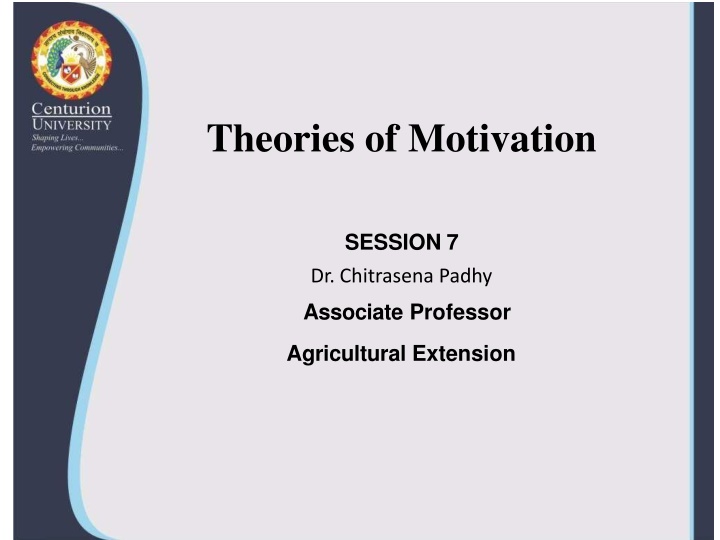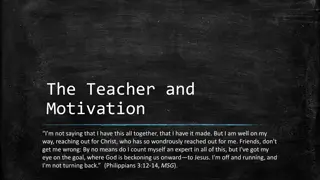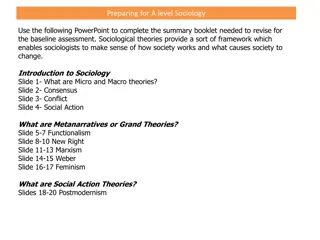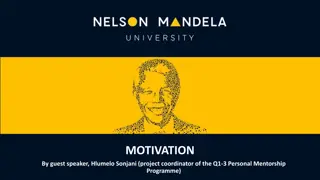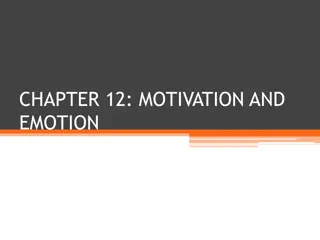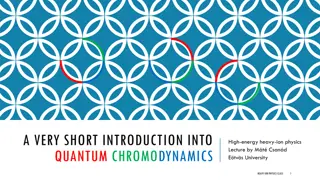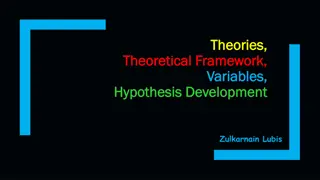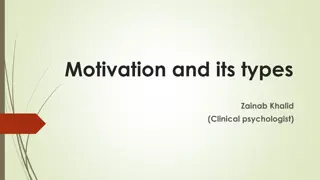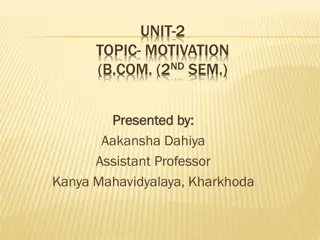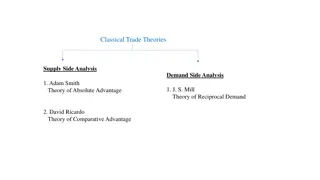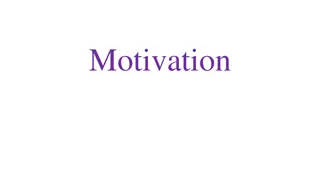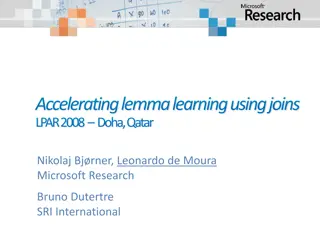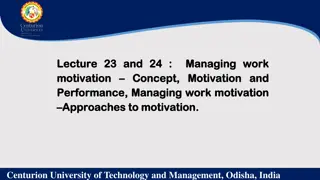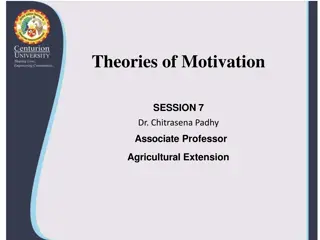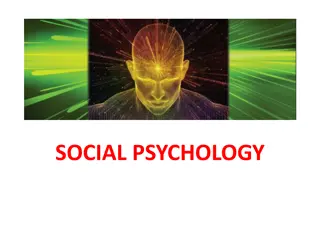Insights into Theories of Motivation and Their Application
Motivation, a driving force behind human behavior, is explored through various theories like Maslow's hierarchy of needs, McClelland's learned needs theory, and others. Understanding these theories can help organizations enhance worker productivity by addressing different motivational factors.
Download Presentation

Please find below an Image/Link to download the presentation.
The content on the website is provided AS IS for your information and personal use only. It may not be sold, licensed, or shared on other websites without obtaining consent from the author.If you encounter any issues during the download, it is possible that the publisher has removed the file from their server.
You are allowed to download the files provided on this website for personal or commercial use, subject to the condition that they are used lawfully. All files are the property of their respective owners.
The content on the website is provided AS IS for your information and personal use only. It may not be sold, licensed, or shared on other websites without obtaining consent from the author.
E N D
Presentation Transcript
Theories of Motivation SESSION 7 Dr. Chitrasena Padhy Associate Professor Agricultural Extension
Introduction The term motivation comes from the Latin word movere, referring to the movement of activity. Motivation has as many faces as there are human desires. Motivation is a psychological term that means it cannot be forced on a person. It comes automatically from inside the person as it is the willingness to do the work. ://www.verywellmind.com/what-is-motivation-2795378
Definition of motivation "Motivation is the driving force behind the energy required to complete a task, a lack of motivation will give rise to a lack of driving power behind completing a certain task." https://psychologydictionary.org/motivation/
Types of motivation When an individual performs an action or behavior because the individual is affected by the eternal factors such as rewards or punishments Extrinsic The act of being motivated by internal factors to perform certain actions and behavior Intrinsic ://www.verywellmind.com/what-is-motivation-2795378
Theories of motivation Motivation theories try to explain what motivates human behavior in the hopes of yielding insights that can help organizations to improve the productivity of their workers. Maslow s hierarchy of needs theory McClelland s learned needs theory Alderfer s ERG theory Herzberg s two-factor theory McGregor s Theory X and Theory Y Vroom s expectancy theory Adam s equity theory Carrot and stick theory
Maslows hierarchy of needs theory One of the most widely-known theories of motivation, it arranges human needs in a hierarchy. The lower a need in the hierarchy, the more dominant it is. When a lower-level need is satisfied, the next-level need emerges. The person keeps climbing up the pyramid to reach self-actualization ://byjus.com/biology/maslows- hierarchy-of-needs/
McClellands learned needs theory This theory states that humans learn to desire power, achievement, and affiliation from their experiences and interactions with the world around them ://www.managementstudyhq.com/mc clellands-theory-of-needs-power- achievement-and-affiliation.html
NEED FOR ACHIEVEMENT People who have the drive to excel They like competition and always like to stay at the top They want to do something different from others Cont. NEED FOR POWER Desire to have an impact on others They like to influence others Concerned about their status and prestige NEED FOR AFFILIATION Wants to belong to a group Wants to be liked by others Favors collaboration over competition ://www.managementstudyhq.com/mc clellands-theory-of-needs-power- achievement-and-affiliation.html
Herzbergs two-factor theory Herzberg talks about two factors in his theory that influence motivation. These are motivation and hygiene/maintenance factors and the presence of motivation factors increases job satisfaction whereas the absence of hygiene factors leads to job dissatisfaction ://www.simplypsychology.org/herzbe rgs-two-factor-theory.html
McGregors Theory X and Theory Y McGregor took a different approach while trying to explain what motivates workers. Instead of focusing on human needs like the previous theories did, he focused on the nature of workers and concluded that there are two types of workers https://parsadi.com/mcgregors-x- and-y-theories/
Management techniques of theory x and y MANAGEMENT TECHNIQUES Setting of objectives THEORY X THEORY Y Set by superior Set by superior and workers jointly Leadership style Autocratic Democratic Motivational philosophy Most people must be controlled, directed, or threatened with punishment to get them to put forth adequate effort towards the achievement A system of positive incentives and rewards are required https://parsadi.com/mcgr egors-x-and-y-theories/
Alderfers ERG theory Clayton Alderfer refined Maslow's hierarchy of needs by categorizing Maslow s pyramid into a theory of Existence, Relatedness, and Growth, with a primary focus on esteem and job performance worldofwork.io/2019/02/alderfers-erg- theory-of-motivation/
Vrooms expectancy theory Vroom s expectancy theory of motivation says that individuals are motivated to do something by three things. They are motivated when they value the reward associated with an action, trust that they ll receive the reward if they do a good job and believe that they have the ability to achieve their objectives by working hard. Expectancy (Efforts): This is about what employees expect from their own efforts (expected outcome) and the relation to good performance and outcomes (performance expectancy). Instrumentality (Performance): It refers to the belief and expectation of a person that his performance will lead to a particular desired reward. Valence (Rewards): It refers to the desire of a person with respect to a potential outcome or reward. The reward may be extrinsic or intrinsic.
://www.toolshero.com/psych ology/vrooms-expectancy- theory/
Adams Equity theory According to this theory, motivation is not only influenced by one s effort and how likely one thinks their efforts are going to lead to rewards, but also by how others are rewarded for their efforts. People have a tendency to compare themselves with other. ://www.mindtools.com/a zv3n0k/adams-equity- theory
When a person feels inequity then . Change the input/put more efforts Choose a different referent Quit the job Change the self- perception/re- evaluate others input ://www.mindtools.com/azv3n0k/ada ms-equity-theory
Benthams Carrot and Stick Approach of Motivation This theory suggests a combination of both rewards and penalties for motivation. the rewards are given in the form of money, promotion, and any other financial or non-financial benefits and sometimes the punishments are exerted to push an individual towards the desired behavior. ://managementweekly. org/stick-and-carrot- theory/
How to Increase Motivation Levels Set goals Make sure to reward yourself every time you achieve your weekly goals Get inspired Have a rest after hard work Overcome fears and obstacles
